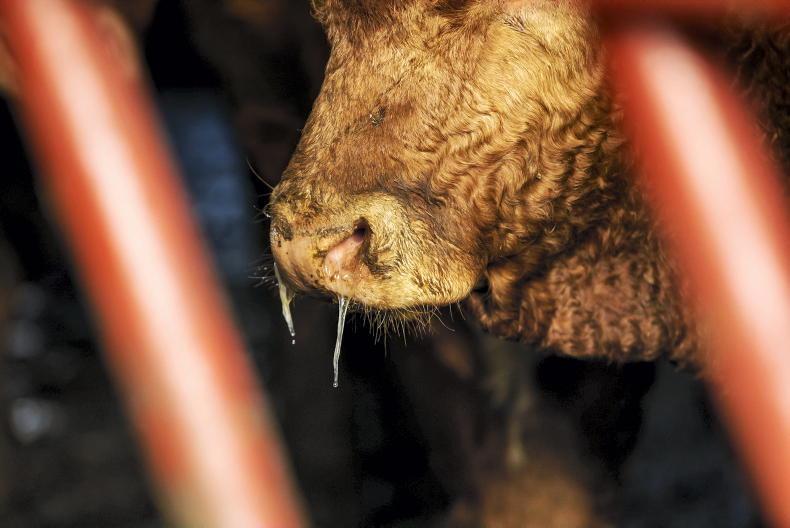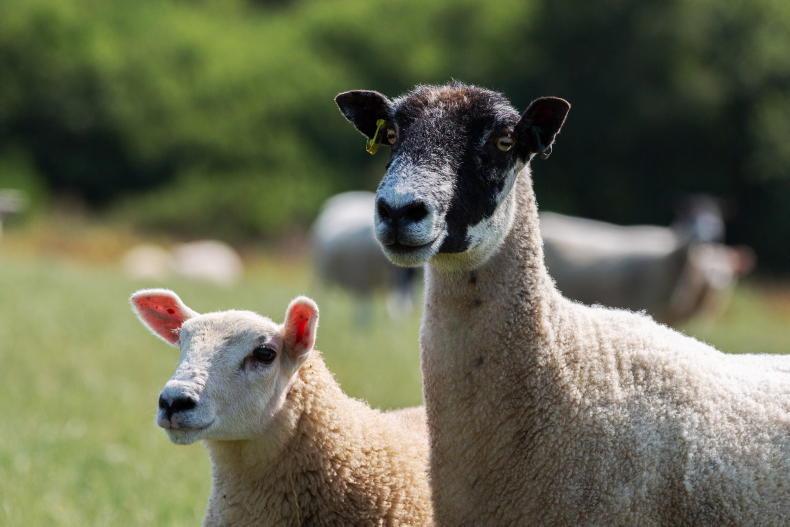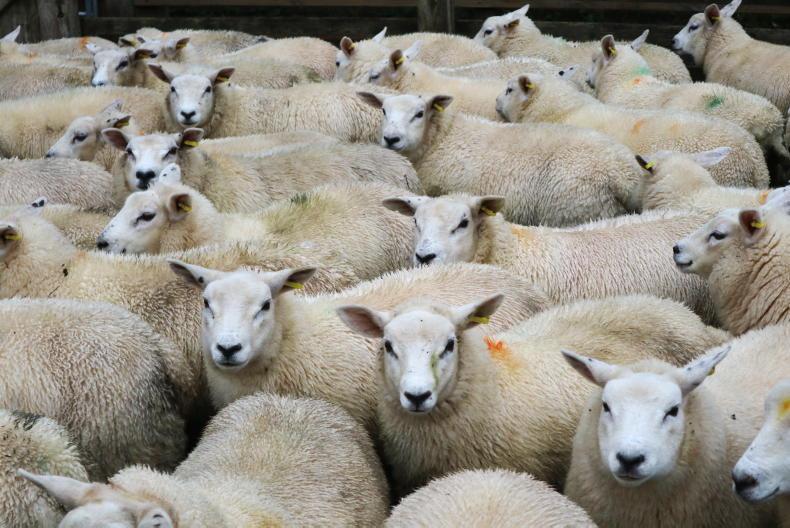Preparations for this year’s lambing season will for many flocks be less than ideal. Ewe body condition is on average lower than recent years and this is combined with an added challenge of a major increase in production costs.
Many feed suppliers report sales of concentrates running much lower than normal for the time of year, which points to some farmers cutting back on late pregnancy feeding programmes in a bid to curtail costs.
A number of vets are also pointing to the possibility of greater health issues with metabolic diseases, such as twin lamb disease, grass tetany and milk fever raised as significant risks.
This article details an overview of each ailment, the tell-tale signs to be on the lookout for, treatment protocols and preventative measures that can be taken.
Twin lamb disease (pregnancy toxaemia)
Pregnancy toxaemia or what is commonly known as twin lamb disease is a relatively common ailment of ewes during late pregnancy.
It is a metabolic condition that occurs when the nutritional demands of the lamb(s) in the womb and ewe maintenance requirements exceed the dietary intake of energy by the ewe.
As can be expected, it is more common in ewes carrying multiple lambs due to the higher nutritional demands, with the highest risk in the final three to four weeks of gestation.
In an effort to supply the nutritional requirements of the lambs in the face of inadequate energy intake, the ewe mobilises fat reserves.
The fat is broken down to ketones, which in turn have negative effects
A characteristic sign is a sweet smell off the breath of a ewe which is affected. Advanced cases have a poor prognosis of recovery, which reinforces the importance of correct diet formulation in late pregnancy.
There are numerous predisposing factors. Ewes offered poor-quality forage are at greater risk due to lower energy intake, while wet silage can also be a predisposing factor, as the higher water content reduces the energy density of the feed.
Health issues are also a common contributor. Concurrent parasitic infestations (worms, liver fluke or rumen fluke) reduce the availability of nutrients in the diet while lameness and a poor mouth can impair intake.
Management also has a role to play with feeding space in particular important to get right.
Most people link twin lamb disease with thin ewes but it can commonly occur in over-conditioned ewes (BCS of >4) that have diminished appetites with their fat reserves more easily mobilised, again making them more susceptible to the condition.
Treatment
The principal treatment route is the oral administration of glycerol or propylene glycol two to three times per day. In more severe cases, intravenous dextrose or glucose may be administered, but the prognosis in such cases is generally poor.
In late pregnancy, ewes may be induced to lamb to reduce the metabolic demands on the ewe.
Prevention
This is a condition that can be avoided by good nutritional management.
Ewes should ideally have a condition score of three (2.5 plus for hill ewes) coming up to lambing, and this should be assessed at breeding and again mid-pregnancy to ensure the body condition targets are achieved.
Pregnancy scanning is central to feeding ewes accordingly and, as mentioned above, management factors and trough space in particular can have a big influence.
While not common, a metabolic profile of ewes in late pregnancy can be carried out looking specifically at beta hydroxybutyrate levels, which will give a good indication of the nutritional status of ewes and indicate if any corrective action needs to be taken.
Hypocalcaemia (low blood calcium) and hypomagnesaemia (low blood magnesium) may be concurrent to twin lamb disease and therefore it is important to ensure that the diet is adequately balanced with minerals/vitamins.
Grass tetany
The second metabolic disease of sheep that occurs quite commonly is grass tetany. It is caused by low blood magnesium levels and is most common in spring during early lactation when a ewe’s system is under considerable pressure to produce milk.
Animals have a poor ability to store magnesium and must ingest sufficient levels on a daily basis to prevent a deficiency.
The level of magnesium absorbed from forage is depressed by a number of factors including high nitrogen fertilisation, rapidly growing swards, high potassium levels in the soil and the rapid transfer of leafy grass material through the animal’s system.

Grass tetany is caused by a deficit of magnesium with a number of stress factors capable of triggering disease. \ David Ruffles
The disease is generally triggered when the above conditions combine with factors that put animals under stress such as a nutritional intake deficit, changes to their diet, difficult weather conditions or any other factor that unduly increases stress levels.
Prevention centres on ensuring animals achieve their daily magnesium intake. This can take the form of supplementation while reducing the rate of forage digestion will also help.
Supplementation should be introduced two to three days in advance of the high-risk period
Supplementation can take many forms, including offering ewes access to high-mag lick buckets, feeding concentrates containing magnesium, administering magnesium bullets or the addition of magnesium to water.
The latter is less reliable in periods of heavy rainfall, while another option of dusting pasture with calcined magnesite is also less viable.
Supplementation should be introduced two to three days in advance of the high-risk period to ensure that blood magnesium levels are adequate and can withstand challenges that may present in the following days.
The onset of disease is rapid with ewes often found dead without exhibiting any clinical symptoms.
This sometimes occurs after ewes and lambs are moved from bare pasture to lush leafy swards, with high nitrogen and potassium levels and with a dip in temperatures also increasing the risk.
Characteristic signs include animals isolating themselves from the flock, muscle tremors and animals stretched out and kicking due to the muscle tremors.
Ewes suckling multiple lambs are also at a higher risk due to higher nutritional stress.
As the onset of disease is so rapid, prevention is the best cure. Where animals are identified, swift treatment by administering magnesium intravenously is essential to improve the chances of a successful recover.
Milk fever
Milk fever is another metabolic condition that is not too dissimilar to twin lamb disease. It generally occurs in the final six to eight weeks of gestation (highest risk in the final three weeks), but can also hit in early lactation.
It stems from a massive demand for calcium during this period and usually hits when anything interferes with normal calcium mobilisation.
For example, a sharp reduction in intake will limit the absorption of calcium from the diet.
Animals can respond by mobilising calcium from their bones, but this will take 48 to 72 hours to achieve, potentially leaving animals with a deficit and reducing calcium blood levels.
It is for this reason that milk fever can often strike at the same time as twin lamb disease. Again, it is most commonly associated with ewes carrying multiple lambs due to the higher demand.
Clinical symptoms
The characteristic signs are closely related to twin lamb disease. Ewes appear dull and lethargic, with a fast heart rate and possibly bloating and salivating.
The disease can advance quickly to depression and coma, with ewes frequently found laying flat with their head stretched and chin lying on the ground.
It is also not uncommon for multiple animals to succumb to the disease or for an outbreak to occur where there are significant changes in management.
Once animals are identified promptly, the success of treatment is quite high.
It involves administration of warm calcium under the skin with a fast response confirming milk fever is the correct diagnosis.
The ailment can be best prevented by ensuring the diet is adequately formulated in late pregnancy and early lactation.
Sharp changes to the diet should be avoided and, again, it is important to ensure the environment animals are in does not limit intake.
Concentrates should be balanced with minerals and vitamins, particularly where a high cereal diet and straw is being offered.
Preparations for this year’s lambing season will for many flocks be less than ideal. Ewe body condition is on average lower than recent years and this is combined with an added challenge of a major increase in production costs.
Many feed suppliers report sales of concentrates running much lower than normal for the time of year, which points to some farmers cutting back on late pregnancy feeding programmes in a bid to curtail costs.
A number of vets are also pointing to the possibility of greater health issues with metabolic diseases, such as twin lamb disease, grass tetany and milk fever raised as significant risks.
This article details an overview of each ailment, the tell-tale signs to be on the lookout for, treatment protocols and preventative measures that can be taken.
Twin lamb disease (pregnancy toxaemia)
Pregnancy toxaemia or what is commonly known as twin lamb disease is a relatively common ailment of ewes during late pregnancy.
It is a metabolic condition that occurs when the nutritional demands of the lamb(s) in the womb and ewe maintenance requirements exceed the dietary intake of energy by the ewe.
As can be expected, it is more common in ewes carrying multiple lambs due to the higher nutritional demands, with the highest risk in the final three to four weeks of gestation.
In an effort to supply the nutritional requirements of the lambs in the face of inadequate energy intake, the ewe mobilises fat reserves.
The fat is broken down to ketones, which in turn have negative effects
A characteristic sign is a sweet smell off the breath of a ewe which is affected. Advanced cases have a poor prognosis of recovery, which reinforces the importance of correct diet formulation in late pregnancy.
There are numerous predisposing factors. Ewes offered poor-quality forage are at greater risk due to lower energy intake, while wet silage can also be a predisposing factor, as the higher water content reduces the energy density of the feed.
Health issues are also a common contributor. Concurrent parasitic infestations (worms, liver fluke or rumen fluke) reduce the availability of nutrients in the diet while lameness and a poor mouth can impair intake.
Management also has a role to play with feeding space in particular important to get right.
Most people link twin lamb disease with thin ewes but it can commonly occur in over-conditioned ewes (BCS of >4) that have diminished appetites with their fat reserves more easily mobilised, again making them more susceptible to the condition.
Treatment
The principal treatment route is the oral administration of glycerol or propylene glycol two to three times per day. In more severe cases, intravenous dextrose or glucose may be administered, but the prognosis in such cases is generally poor.
In late pregnancy, ewes may be induced to lamb to reduce the metabolic demands on the ewe.
Prevention
This is a condition that can be avoided by good nutritional management.
Ewes should ideally have a condition score of three (2.5 plus for hill ewes) coming up to lambing, and this should be assessed at breeding and again mid-pregnancy to ensure the body condition targets are achieved.
Pregnancy scanning is central to feeding ewes accordingly and, as mentioned above, management factors and trough space in particular can have a big influence.
While not common, a metabolic profile of ewes in late pregnancy can be carried out looking specifically at beta hydroxybutyrate levels, which will give a good indication of the nutritional status of ewes and indicate if any corrective action needs to be taken.
Hypocalcaemia (low blood calcium) and hypomagnesaemia (low blood magnesium) may be concurrent to twin lamb disease and therefore it is important to ensure that the diet is adequately balanced with minerals/vitamins.
Grass tetany
The second metabolic disease of sheep that occurs quite commonly is grass tetany. It is caused by low blood magnesium levels and is most common in spring during early lactation when a ewe’s system is under considerable pressure to produce milk.
Animals have a poor ability to store magnesium and must ingest sufficient levels on a daily basis to prevent a deficiency.
The level of magnesium absorbed from forage is depressed by a number of factors including high nitrogen fertilisation, rapidly growing swards, high potassium levels in the soil and the rapid transfer of leafy grass material through the animal’s system.

Grass tetany is caused by a deficit of magnesium with a number of stress factors capable of triggering disease. \ David Ruffles
The disease is generally triggered when the above conditions combine with factors that put animals under stress such as a nutritional intake deficit, changes to their diet, difficult weather conditions or any other factor that unduly increases stress levels.
Prevention centres on ensuring animals achieve their daily magnesium intake. This can take the form of supplementation while reducing the rate of forage digestion will also help.
Supplementation should be introduced two to three days in advance of the high-risk period
Supplementation can take many forms, including offering ewes access to high-mag lick buckets, feeding concentrates containing magnesium, administering magnesium bullets or the addition of magnesium to water.
The latter is less reliable in periods of heavy rainfall, while another option of dusting pasture with calcined magnesite is also less viable.
Supplementation should be introduced two to three days in advance of the high-risk period to ensure that blood magnesium levels are adequate and can withstand challenges that may present in the following days.
The onset of disease is rapid with ewes often found dead without exhibiting any clinical symptoms.
This sometimes occurs after ewes and lambs are moved from bare pasture to lush leafy swards, with high nitrogen and potassium levels and with a dip in temperatures also increasing the risk.
Characteristic signs include animals isolating themselves from the flock, muscle tremors and animals stretched out and kicking due to the muscle tremors.
Ewes suckling multiple lambs are also at a higher risk due to higher nutritional stress.
As the onset of disease is so rapid, prevention is the best cure. Where animals are identified, swift treatment by administering magnesium intravenously is essential to improve the chances of a successful recover.
Milk fever
Milk fever is another metabolic condition that is not too dissimilar to twin lamb disease. It generally occurs in the final six to eight weeks of gestation (highest risk in the final three weeks), but can also hit in early lactation.
It stems from a massive demand for calcium during this period and usually hits when anything interferes with normal calcium mobilisation.
For example, a sharp reduction in intake will limit the absorption of calcium from the diet.
Animals can respond by mobilising calcium from their bones, but this will take 48 to 72 hours to achieve, potentially leaving animals with a deficit and reducing calcium blood levels.
It is for this reason that milk fever can often strike at the same time as twin lamb disease. Again, it is most commonly associated with ewes carrying multiple lambs due to the higher demand.
Clinical symptoms
The characteristic signs are closely related to twin lamb disease. Ewes appear dull and lethargic, with a fast heart rate and possibly bloating and salivating.
The disease can advance quickly to depression and coma, with ewes frequently found laying flat with their head stretched and chin lying on the ground.
It is also not uncommon for multiple animals to succumb to the disease or for an outbreak to occur where there are significant changes in management.
Once animals are identified promptly, the success of treatment is quite high.
It involves administration of warm calcium under the skin with a fast response confirming milk fever is the correct diagnosis.
The ailment can be best prevented by ensuring the diet is adequately formulated in late pregnancy and early lactation.
Sharp changes to the diet should be avoided and, again, it is important to ensure the environment animals are in does not limit intake.
Concentrates should be balanced with minerals and vitamins, particularly where a high cereal diet and straw is being offered.










SHARING OPTIONS